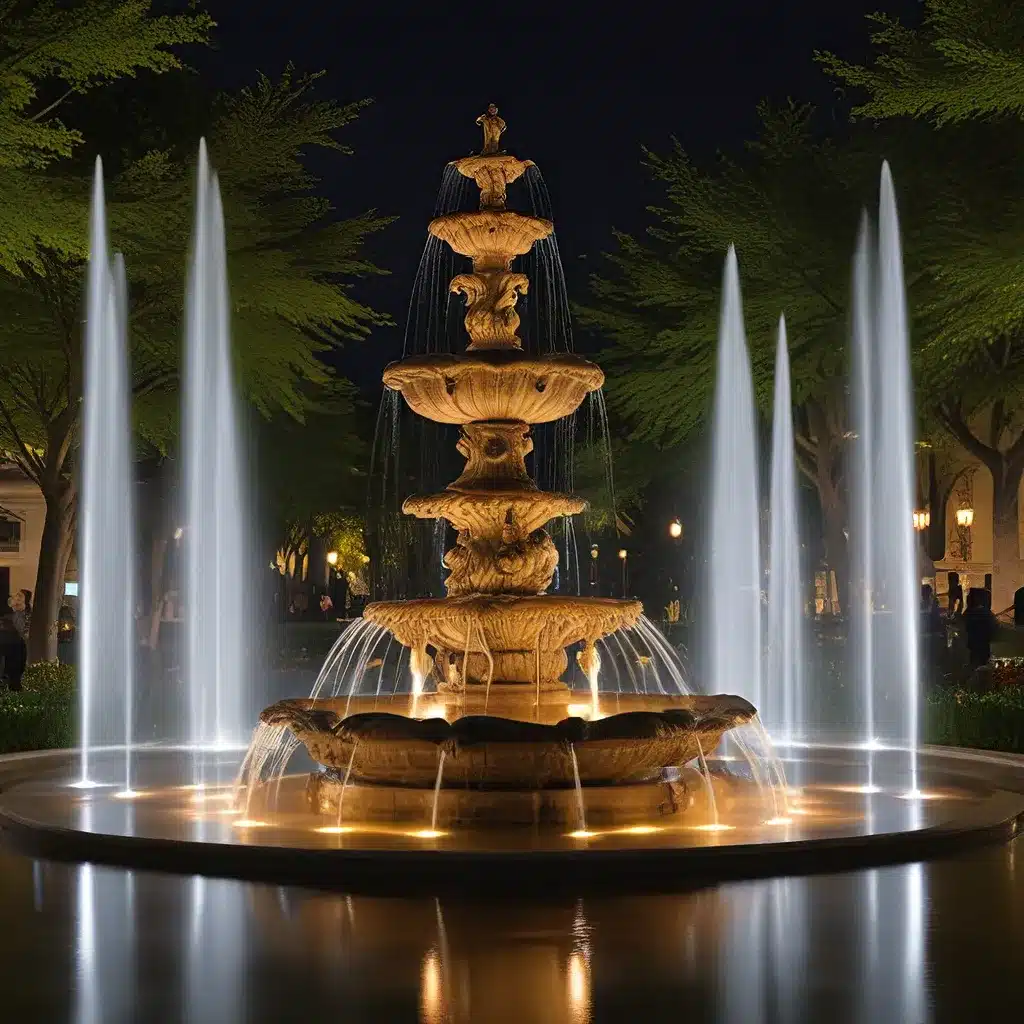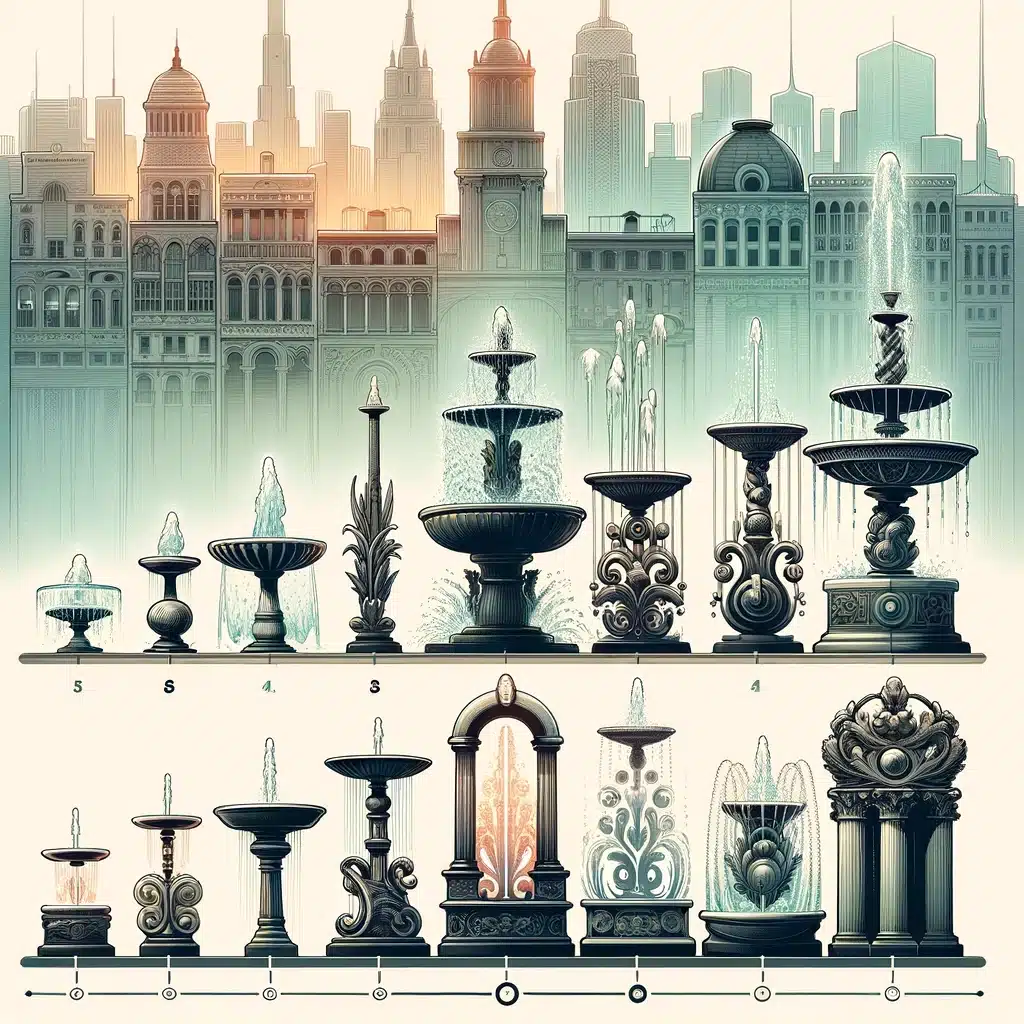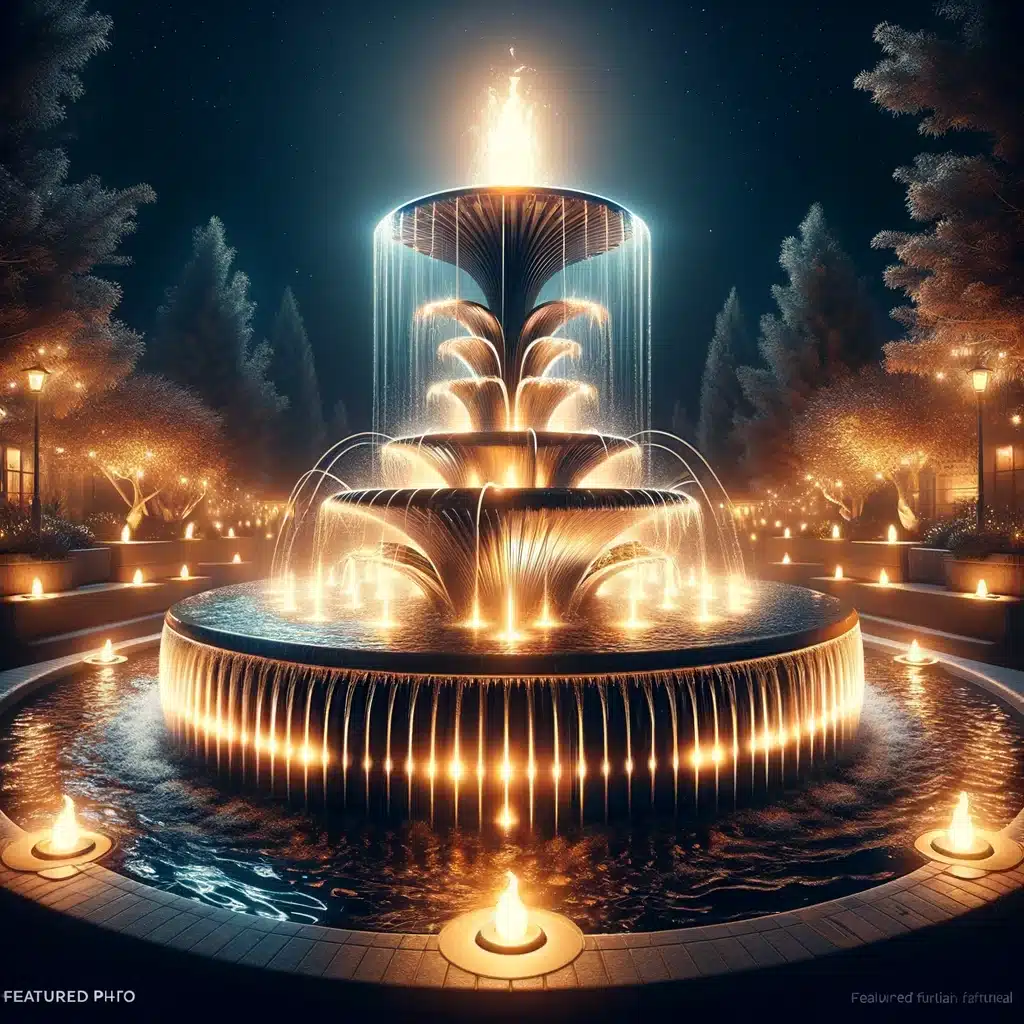
Fountain Design Essentials – Welcome to Fountain Lights
Fountain Design Essentials – Welcome to Fountain Lights
Water features and fountains have long been prized elements in landscape and architectural design. The soothing sound of cascading water combined with artistic illumination creates an ambiance of serenity and beauty. Proper lighting allows fountains to make a dramatic visual statement, while the integration of heaters enables fountains to operate year-round in colder environments.
When designed well, illuminated and heated fountains become true works of art. Strategic lighting transforms fountains into vivid nighttime accents, while heaters prevent freezing to allow for uninterrupted performance. With modern innovations in fountain technology, there are abundant possibilities for aesthetically enhancing waterscapes through the creative use of lighting and heating.
In this comprehensive guide, we will explore the nuances of utilizing lighting and heating in fountain design to elevate visual impact and versatility. We will cover key technical considerations, delve into aesthetic principles, highlight evolving technologies, and provide tips for safety, maintenance, and efficiency. Whether you are looking to install a new heated fountain or enhance an existing water feature, this guide will provide invaluable insights and inspiration.
While fountains have existed for millennia in different forms, contemporary fountain design has been shaped by artistic movements and technological advancements. Modern fountains emerged as civic monuments and decorative garden accents in Europe during the Renaissance and Baroque eras. Elaborate Roman fountains were an inspiration, featuring dramatic sculptures, cascades, and pools.

Later, the Beaux-Arts movement brought monumental, classically-inspired fountains and aquatic gardens to cities like Paris and London. In the early 1900s, Art Nouveau fountains featured ornate, organic shapes based on natural forms. As electricity became widespread in the 1920s, illuminating fountains with underwater lights came into vogue, adding a magical quality to the cascading water.
The mid-late 20th century saw a move toward minimalism with Bauhaus and modernist fountains based on simple geometric forms and abstraction. The 1970s and 80s brought renewed interest in natural shapes and materials like stone, which became a signature of contemporary landscape fountains.
Recent decades have seen greater creativity and diversity in fountain design, with customization for settings from urban plazas to private backyards. Advancing water feature technologies like LED lighting, solar power, and creative water flow allow for ever more dynamic and eco-friendly fountains.
Fountain heaters are used to prevent water freezing in cold temperatures, allowing fountains to operate year-round. They work by maintaining a minimum water temperature to keep water flowing smoothly in any climate. There are several heater types suited to different needs:
Proper installation and maintenance are key to ensure heaters work safely and keep fountains flowing in frigid weather. Heaters prevent winter weather from damaging fountain components while making fountains more attractive year-round.
Together, creative lighting design and strategic heating enable fountains to make a spectacular visual impact at any time of year. During the day, sunlight reflecting off water creates a fluid dance of light. Thoughtful placement of lights illuminates this movement at night, allowing fountains to shine as centerpiece features and art installations.
By preventing ice buildup and enabling water flow in cold months, heaters also ensure fountains remain visually appealing. Heaters bring out the best in floating and submerged lights by keeping water transparent and in motion. Their integration allows fountains to maintain their aesthetic integrity regardless of season.

Beyond visual appeal, lighting and heating work together to create pleasant experiences for people. Colorful, well-lit fountains have an uplifting energy, while the warm microclimate around heated water provides comfort. This multi-sensory effect enhances fountains’ abilities to soften and humanize public spaces.
Aesthetically powerful illuminated fountains require careful orchestration of various electrical, lighting, and water flow components. Key elements include:
Water pumps – Reliable pumps are critical for moving water to create the desired fountain shapes and cascades. Submersible pumps are often used for durability and easy maintenance.
Plumbing – Durable, non-corrosive piping safely delivers water throughout the system. Flexible tubing allows adjustment of fountain heights and formations.
Lighting – LED lighting offers extensive design flexibility with low energy use. Fixtures include overhead spotlights, underwater lights, and color-changing lights.
Controls – Smart controls range from simple timers to complex programs allowing elaborate lighting sequences and effects.
Power – Electrical components require proper wiring and circuits. Many modern fountains run on solar power for convenience and sustainability.
Basins – Basins hold water reservoirs for fountain recirculation. Materials like concrete and fiberglass provide durability.
By harmonizing these elements, illuminated fountains can make a spectacular aesthetic statement. Thorough planning and technical execution bring creative visions to life.
Fountains operate in demanding environments, enduring constant moisture, weather fluctuations, mineral deposits, and wear and tear. Maximizing fountain longevity requires selecting robust, non-corrosive materials and utilizing quality construction techniques.
Basins & Piping: Reinforced concrete, weather-resistant metals like stainless steel, and durable composites like fiberglass make sturdy, long-lasting structural components.
Finishes: Materials should have low porosity and permeability to prevent water absorption and damage. Popular options include mosaic tile, pebbled aggregate finishes, and natural stone.
Waterproofing: Waterproof membranes and sealants protect components against leaks and corrosion. High-quality pumps, plumbing fittings, and lighting fixtures resist damage.
Freezing Prevention: In colder climates, deep basins, insulation, sloped bases, and heaters prevent frost damage.
Stable Foundations: Reinforced foundations, concealed plumbing, and anchored components ensure stability.
Maintenance Access: Fountain designs allow easy access to lighting, pumps, wiring, and plumbing for maintenance and repairs.
With rigorous construction techniques and quality materials, fountains can provide enduring beauty and reliable operation for decades.
Light transforms stationary water into a fluid canvas, making fountain illumination an art unto itself. Applying core principles creates drama and visual harmony:
Highlight focal points – Strategically illuminate key statues, water jets, or central streams to draw attention.
Balance light colors – Mixing cool and warm white lights creates a pleasing contrast. Use accent colors judiciously.
Hide light sources – Conceal fixtures with landscaping or architectural features for a magical quality.
Uplight water – Light projected upwards through water makes it sparkle. Position lights in basins or under streams.
Use dramatic contrasts – Alternating bright illumination and shadow builds depth and interest.
Sync with water flow – Pulsing or color-changing lights synced to the cadence of water enhance movement.
Accent design details – Showcase interesting fountain textures, patterns or features with targeted lighting.
With thoughtful orchestration of these techniques, brilliant fountain illumination becomes an artistic practice in itself.
Sustainability is an increasingly important consideration in fountain design. Specifying energy-efficient components, harnessing renewable power, and using recycled water mitigates fountains’ environmental impacts:
Applying these strategies allows fountains to enhance spaces beautifully while ensuring sustainable, responsible water and energy usage.
The advent of LED technology has revolutionized fountain lighting possibilities:
Continued LED technology improvements will enable ever more sophisticated fountain displays while reducing energy consumption and maintenance.
Proper heater placement is crucial for efficiently and safely warming fountain water. Ideal heater location depends on factors like:
Careful testing is advised to identify cold spots and adjust heater placement as needed. Proper positioning keeps water moving and prevents icy buildup. This ensures both effective heating and attractive fountain operation all winter long.
Besides maintaining function in cold weather, fountain heaters enhance the overall sensory experience:
Sight – Clear, flowing water remains visually appealing rather than icing over in winter. Gentle steam creates a tranquil atmosphere.
Sound – Heaters keep water circulating to produce pleasant sounds. They prevent disruptive noises from frozen or grinding fountain components.
Temperature – Radiant warmth from heated water provides physical comfort and an inviting ambiance for winter garden areas.
Smell – Heat prevents stagnant water smells from funky organic buildup. The air fills with refreshing humidity instead.
Touch – Heated fountain basins allow for dipping hands safely on cold days. The lack of ice reduces slip hazards.
Integrating heaters into fountains’ technical systems elevates environments year-round for all senses, bringing multi-layered tranquility.
The most successful fountains artfully integrate functional water systems with aesthetic design:
Blending engineering and art, well-designed fountains come alive with the dynamic interplay of water, light, and form.
Exciting fountain technologies are being pioneered to enhance underwater aesthetics:
These cutting-edge innovations open new creative possibilities for fountain designers to explore.
Several scientific factors ensure fountain heaters work efficiently:
Applying the science behind heat transfer allows fountain designers to create reliably warm, visually stunning water features.
Fountain lighting serves both aesthetic and functional purposes. Strategic illumination enhances nighttime visibility for safety:
Blending visibility-oriented lighting seamlessly into the overall fountain aesthetic creates a safe and dazzling nighttime environment.
Fountains require specialized seasonal care to sustain beauty and function:
Spring
Summer
Autumn
Winter
Staying vigilant through changing seasons keeps fountains looking beautiful and operating smoothly.
One of the joys of fountain design is tailoring water forms, lighting, and heating features for specific spaces:
Courtyards – Natural stone basins and rills cascading down walls complement the surrounding architecture beautifully. Radiant in-ground heating preserves plant life.
City plazas – Programmable fountain jets and lighting allow dynamic shows for crowds. Extreme weather packages maintain four-season performance.
Backyards – Intimate handcrafted water bowls with butterflies, chimes, and uplighting create personal hideaways. Compact solar heaters keep smaller water volumes from freezing.
Indoor atriums – Subtle wall-mounted water curtains and recessed lighting avoid visual distractions. Inline heaters recirculate warmed water through exposed feature pipes.
Rooftop gardens – Fiberglass basins minimize weight loads. Solar pumps and LEDs run off renewable power. Freeze preventionPriorities wind resistance.
The diversity of fountain possibilities makes customizing designs an artistic adventure.
Strategically incorporating heaters improves fountain lifespan in cold climates by:
Incorporating heaters upfront during design or upgrading existing fountains to include heating systems leads to lower long-term costs and extended fountain longevity.
Various strategies can curb energy use and costs in operating illuminated, heated fountains:
With thoughtful design and features, fountains can dazzle visitors while maintaining respectable energy and cost profiles.
Proper precautions protect people and prevent system damage during installation and maintenance:
Vigilance in design, construction, and testing ensures illuminated fountains remain safe gathering places for all.
Fountain design continues to evolve in novel directions:
The fountain possibilities are boundless as designers push conventions to build increasingly enchanting, technologically advanced, and environmentally responsible water features.
Technology elevates both aesthetic appeal and functionality of modern fountain systems:
Technology integration sparks creative possibilities while simplifying reliable operation in sophisticated fountains.
Making fountains easy and enjoyable to operate ensures they get used as intended. Thoughtful designs minimize complexity:
Simplified technology, programming, and remote capabilities let fountain owners enjoy the tranquil ambiance hands-free!
Proactive maintenance keeps fountains looking and functioning their best:
Various troubleshooting strategies can address common issues with heated and illuminated fountains:
Cloudy water – Shock chlorinate and clean filters. Reduce run times. Check water chemistry.
Mineral deposits – Wipe surfaces and use scale inhibitors. Adjust pH. Increase circulation.
Electrical faults – Ensure GFCIs or circuit breakers are appropriately sized. Check for loose, frayed or improperly terminated wires.
Leaks – Verify water chemistry balance. Re-seal cracks and replace aged gaskets/fittings.
Heater malfunctions – Clean built-up limescale on elements. Position heaters to maximize water flow. Replace damaged units.
Pump noise/failure – Refill water to proper level. Clean inlets/impellers. Replace worn impellers. Consider upsizing pump.
Lights out – Replace bulbs/fixtures. Check wiring and connectors. Eliminate kinks in cable runs. Replace transformers or boosters if inadequate voltage.
Freezing – Insulate pipes and basins. Increase heater capacity. Add wind shields.
Hospital Courtyard (Denver, CO)
Challenge: Create a soothing heated refuge for patients and visitors through harsh winters.
Solution: Installed a 13-foot diameter circular fountain featuring color-changing LEDs and two 1 kW inline heaters which maintain 72°F water temperature down to -10°F ambient.
Corporate Plaza (Calgary, AB)
Challenge: Transform an outdated existing fountain into a vivid year-round centerpiece.
Solution: Added new programmable RGB lighting, upgraded pumps for more lively jets, replaced old piping, and installed four submersible 2 kW heaters to enable winter enjoyment.
Botanical Garden Waterfall (Chicago, IL)
Challenge: Prevent a large 20-foot waterfall and stream from icing over in winter while blending with nature.
Solution: Inconspicuously placed radiant in-ground heating pads below rocks and stream bottom to keep water flowing and prevent hazardous icy areas.
The fountain experience continues to advance through emerging technologies and design philosophies:
Tomorrow’s fountains will amaze visitors with ever-more delightful sights, sounds, sensations, and experiences!
Subtle considerations maximize fountains’ visual appeal:
Careful refinement of these aesthetic elements creates a visually engaging fountain that delights as a coherent whole.
There are many ways to implement brilliant, functional fountains on a budget:
With smart planning and strategic trade-offs, spectacular heated, illuminated fountains can be created on limited budgets.
Proper lighting profoundly impacts how water elements are experienced:
Visibility – Lighting allows fountains and pools to be used and appreciated after dark. Subtle accent lighting prevents accidents.
Focus – Illumination guides attention to the most aesthetically interesting water and architectural feature areas.
Color – Tinted lighting transforms plain water into a rainbow canvas. Warm light conveys comfort.
Texture – Shadows and light massing intensify the visual texture of water, accentuating the fountain’s form.
Kinetic motion – Moving light patterns heighten the sense of water’s dynamic flow and sound for synesthetic effect.
Ambiance – Reflecting and underwater lighting creates a dreamlike, inviting atmosphere to enjoy.
Location emphasis – Carefully lit fountains become beacons drawing people to a space.
Integrating fountains and lighting creates holistic experiences engaging all senses through sight, sound, and atmosphere.
Choosing fountain heaters depends on factors like size, visibility, piping complexity, and ambient conditions:
Considering operational needs, visibility, and environmental factors ensures an optimal heater system design.
Landscape Architect: “Smart fountain design seamlessly integrates with the surrounding hardscape and plantings. We avoid treating fountains as visual one-offs.”
Civil Engineer: “Understand seasonal hydrological factors when siting fountains. Avoid flood-prone areas or provisions to prevent damage must be incorporated.”
Urban Planner: “Well-designed fountains bring people together, creating focal points for community interaction and events.”
Fountain Contractor: “Maintenance access should drive many design factors. Simplify equipment connections and placement for easier upkeep.”
Environmental Consultant: “Responsible fountain design minimizes chemical, energy, and water footprints through eco-friendly features.”
Acoustical Engineer: “Use low-noise energy efficient pumps to prevent fountains from becoming noise nuisances.”
Experts help maximize fountains’ beauty, enjoyment, and longevity when collaborative design insight is embraced.
Thoughtful incorporation of participatory elements transforms fountains into playful attractions:
Letting people directly engage with fountains forges lasting memories and place attachment. The joy is infectious!
Several codes and regulations apply to fountain construction:
While allowing ample design creativity, codes and regulations aim to protect public health, safety, resources, and equal access.
This exploration has illuminated how strategic incorporation of lighting and heating unlocks fountains’ full artistic potential.
Thoughtfully combining aesthetics and engineering creates transcendent, multi-sensory spaces. visitors connect with on a primal level. Light and heat enable fountains to make universal emotional statements in any season or setting.
From subtle backyard tranquility to grandCopy
continue
S
Here is more of the conclusion:
This exploration has illuminated how strategic incorporation of lighting and heating unlocks fountains’ full artistic potential.
Thoughtfully combining aesthetics and engineering creates transcendent, multi-sensory spaces visitors connect with on a primal level. Light and heat enable fountains to make universal emotional statements in any season or setting.
From subtle backyard tranquility to grand civic displays, fountains speak a language beyond words when enhanced by careful illumination and heating. Water entrances minds, lighting focuses intention, and warmth beckons the body.
Technology continues to expand design possibilities, enabling increasingly dynamic and sustainable water art installations. But the foundations remain timeless. As long as water flows gracefully and glows under moon or sun, fountains will serve as testaments to human creativity aligned with nature’s wonder.
When heat and light intertwine with water, mundane spaces transform into profound sensory havens that revitalize body and spirit. The future promises ever more wondrous possibilities to explore.
Share to :
Subscribe to our newsletter for the latest in fountain design, innovative lighting ideas, and exclusive tips straight to your inbox. Join the community shaping the future of water features.

Rapid delivery to your doorstep.

Excellence in every product.

Great value for your investment.

Assistance at any hour.
Fountain Lights — Illuminating creativity in every splash!
Copyright © 2023. All Right Reserved